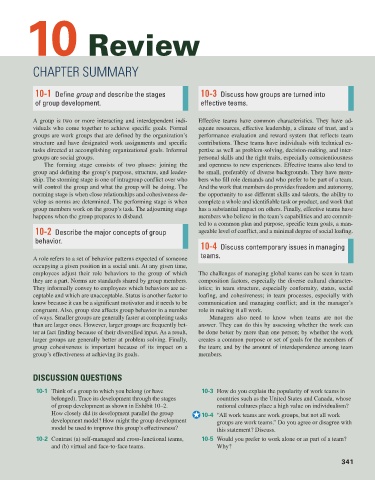Page 342 - Fundamentals of Management Myths Debunked (2017)_Flat
P. 342
10 Review
CHAPTER SUMMARY
10-1 Define group and describe the stages 10-3 Discuss how groups are turned into
of group development. effective teams.
A group is two or more interacting and interdependent indi- Effective teams have common characteristics. They have ad-
viduals who come together to achieve specific goals. Formal equate resources, effective leadership, a climate of trust, and a
groups are work groups that are defined by the organization’s performance evaluation and reward system that reflects team
structure and have designated work assignments and specific contributions. These teams have individuals with technical ex-
tasks directed at accomplishing organizational goals. Informal pertise as well as problem-solving, decision-making, and inter-
groups are social groups. personal skills and the right traits, especially conscientiousness
The forming stage consists of two phases: joining the and openness to new experiences. Effective teams also tend to
group and defining the group’s purpose, structure, and leader- be small, preferably of diverse backgrounds. They have mem-
ship. The storming stage is one of intragroup conflict over who bers who fill role demands and who prefer to be part of a team.
will control the group and what the group will be doing. The And the work that members do provides freedom and autonomy,
norming stage is when close relationships and cohesiveness de- the opportunity to use different skills and talents, the ability to
velop as norms are determined. The performing stage is when complete a whole and identifiable task or product, and work that
group members work on the group’s task. The adjourning stage has a substantial impact on others. Finally, effective teams have
happens when the group prepares to disband. members who believe in the team’s capabilities and are commit-
ted to a common plan and purpose, specific team goals, a man-
10-2 Describe the major concepts of group ageable level of conflict, and a minimal degree of social loafing.
behavior.
10-4 Discuss contemporary issues in managing
teams.
A role refers to a set of behavior patterns expected of someone
occupying a given position in a social unit. At any given time,
employees adjust their role behaviors to the group of which The challenges of managing global teams can be seen in team
they are a part. Norms are standards shared by group members. composition factors, especially the diverse cultural character-
They informally convey to employees which behaviors are ac- istics; in team structure, especially conformity, status, social
ceptable and which are unacceptable. Status is another factor to loafing, and cohesiveness; in team processes, especially with
know because it can be a significant motivator and it needs to be communication and managing conflict; and in the manager’s
congruent. Also, group size affects group behavior in a number role in making it all work.
of ways. Smaller groups are generally faster at completing tasks Managers also need to know when teams are not the
than are larger ones. However, larger groups are frequently bet- answer. They can do this by assessing whether the work can
ter at fact finding because of their diversified input. As a result, be done better by more than one person; by whether the work
larger groups are generally better at problem solving. Finally, creates a common purpose or set of goals for the members of
group cohesiveness is important because of its impact on a the team; and by the amount of interdependence among team
group’s effectiveness at achieving its goals. members.
DIsCussIon QuesTIons
10-1 Think of a group to which you belong (or have 10-3 How do you explain the popularity of work teams in
belonged). Trace its development through the stages countries such as the United States and Canada, whose
of group development as shown in Exhibit 10–2. national cultures place a high value on individualism?
How closely did its development parallel the group 10-4 “All work teams are work groups, but not all work
development model? How might the group development groups are work teams.” Do you agree or disagree with
model be used to improve this group’s effectiveness? this statement? Discuss.
10-2 Contrast (a) self-managed and cross-functional teams, 10-5 Would you prefer to work alone or as part of a team?
and (b) virtual and face-to-face teams. Why?
341

